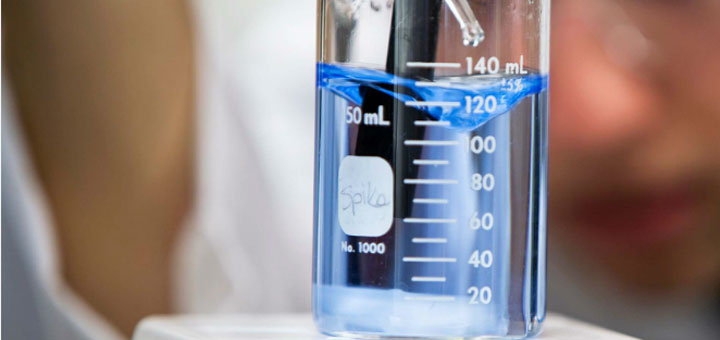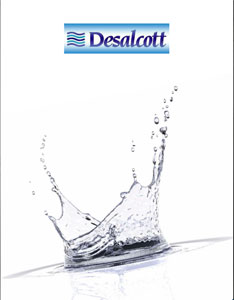Supplying clean water to Trinidad’s industrial sector
Desalination, or desalinization, is a process that removes dissolved salts and minerals from brackish seawater in order to produce clean, fresh water that is unsullied by natural or unnatural contaminants. The Desalination Company of Trinidad and Tobago, Limited (DesalcoTT) is a company whose desalination plant intakes raw seawater from the Gulf of Paria, off the country’s west coast, cleanses it of its mineral content, and then sells the purified water to the island’s Water and Sewerage Authority (WASA), the company’s sole customer.
Approximately half of the produced desalinated water is then re-sold to some 20 processing plants at the government-owned, Point Lisas Industrial Estate, home to a majority of Trinidad and Tobago’s heavy industry.
John Thompson is DesalcoTT’s Managing Director. He recounts the company’s beginnings in 1998: “The company was set up by a local entrepreneur in Trinidad whose name was Hafeez Karamath. He was the owner of a group of companies that did construction, steel work, and related activities, and already had built notable projects, such as the Hall of Justice, the Hilton Hotel in Tobago, and a shopping mall called the Grand Bazaar. He’d also done some work on water treatment plants and the steel work for Atlantic LNG. He saw that Trinidad was moving in the direction of building a desalination plant at Point Lisas to provide security of water supply to the industries there. And so he formed the Desalination Company of Trinidad and Tobago. He sought a joint venture partner who was experienced in desalination technology – Ionics, Inc. out of Boston Massachusetts.”
Originally, DesalcoTT was a joint partnership, with Hafeez Karamath Engineering Services Limited (HKESL) owning 60 percent of the facility and Ionics owning the remaining 40 percent. In 2005, the General Electric Company acquired Ionics, and in 2012, HKESL purchased G.E.’s entire shareholding, making DesalcoTT 100 percent locally owned and operated. Thompson, himself, has been with DesalcoTT since 2000, having come on board as Project Director to run the engineering procurement and construction of the plant on behalf of Ionics. He was confirmed as General Manager in 2002, when the plant first went into operation, and he continues in that position, today.
Unlike some places on the globe that need to rely on desalination because of a lack of suitable fresh water supplies, Trinidad actually has a lot of it, and the island has many dams and reservoirs in use that help capture and distribute it. But, according to Thompson, demand has been increasing over time, both from its industrial sector as well as from a population that is becoming more affluent and is seeking a higher standard of living, which includes more indoor plumbing and the desire for a reliable fresh water supply.
“The demand was somewhere between 200 and 250 million imperial gallons a day,” Thompson explains. “And the main plant capacity of the Water and Sewerage Authority’s plants was about 250. But, in practice, it was considerably less – somewhere in the range of 180-200 imperial gallons a day. And the reason for that is threefold: an aging infrastructure – a fair percentage of it was leaking; old plants, all dating back to the days before independence in 1962; and also a lot of unaccounted-for water.” Much of the unaccounted water was being siphoned off by local farmers, and, because of the aging infrastructure, there were problems of water supply to the Point Lisas Industrial Estate, which because of its high concentration of industry, is the powerhouse of the nation‘s economy.
By August 2002, the plant was beginning to close the gap by producing 22 million imperial gallons a day of desalinated, fresh water. By 2004, it was up to 24 million gallons. “Since then, we have progressively expanded the plant to 40 million gallons by November of 2014. That’s when it was completed,” says Thompson. “And we are in the process of a second phase of the expansion which is giving us more reliability and increased capacity, and providing some redundant systems, so that we can produce the 40 million gallons a day at any time of year. And at certain times of the year, and when everything’s running, will be able to produce somewhere in the region of 48 million imperial gallons a day.”
While DesalcoTT is the country’s largest, and only private, desalination operator, Thompson reports that some competition does exist on the island. There’s a smaller plant at Point Fortin – a public/private partnership between WASA and the U.S.-based Seven Seas Corporation, that produces 5.5 million U.S. gallons per day; and a waste water recovery plant that the government is the process of building that will have a capacity of 10 million imperial gallons a day. (“You multiply 1.2 from imperial gallons to get U.S., so our 40 million gallons a day is actually 48 million U.S. gallons,” Thompson adds.)
As both General Manager of DesalcoTT, as well as the President of the Caribbean Desalination Association, an affiliate of the International Desalination Association, Thompson sees desalination as a growth industry. “The number of desalination plants in the world has been growing exponentially – partially because of climate change and partially because of increased living standards. And the other big factor is that since the technology of reverse osmosis was invented and further developed, it’s become much cheaper to desalinate water than it used to be. As a rough guide, conventional water treatment costs somewhere in the region of 10 U.S. to, maybe 50 U.S. cents per cubic meter of produced water. Desalination used to cost in the region of two to three U.S. dollars per cubic meter. Through reverse osmosis, large plants are producing desalinated water, now, in the range of one U.S. dollar to two U.S. dollars.”
But if desalinized water is still more expensive than water that is conventionally treated, why would WASA’s industrial clients want to pay the extra amount? Thompson explains: “We provide them higher purity water than is generally provided through fresh water sources. Industrial companies require a very high-purity water, higher than what you need to drink. An industrial company needs water that’s distilled, and de-ionized and which has only one or five parts per million of impurities. The World Health Organization’s country standard is that drinking water should have less than 500 parts per million of impurities. Normal water treatment by WASA in Trinidad is pretty good – they probably achieve between 200 and 300 parts per million. But the specification for our water is 85 parts per million. So this means that the industrial companies at Point Lisas have to spend less money on ion-exchange chemicals to get the water down to being the ionized water they need. And the reason they need de-ionized water is because they use steam in their processes and any impurity in the steam means an impure product, or else they use boilers that foul up if there’s impurities in the water.”
Indeed, the fact that Point Lisas’ industrial clients are willing to pay more for desalinated water means that the government of Trinidad, via WASA, can afford to pay DesalcoTT for all of the water it buys, even though only about 19 million gallons a day goes to the industrial estate, with the rest of it going into the general water supply for the population of south Trinidad.
“Essentially,” says Thompson, “the industrial companies are paying for all of the water through the higher water rate they pay.”
Thompson reports that DesalcoTT has approximately 120 employees. “But we employ many, many more – as much as 400 when we do shut-down maintenance. And all the time, we are doing small improvements and maintenance on the plant, so on a regular basis, we are also employing specialist contractors.” He adds that there is scope for further expansion of the Point Lisas plant, and the company, which is now run by Yashmid Karamath, Hafeez’s brother (Hafeez died in 2011), is also looking at the potential of being involved in desalination projects in the Middle East.
As the demand for pure, fresh water continues to grow, DesalcoTT’s continuing mission is to become recognized as a leading supplier of desalinated water throughout the Caribbean region and beyond.
________________
AT A GLANCE
WHO: The Desalination Company of Trinidad & Tobago, Limited
WHAT: Providing desalinated water for the country’s industrial sector
WHERE: Point Lisas, Trinidad, W.I.
WEBSITE: www.desalcott.com.com
PREFERRED VENDORS
First Citizens Bank Ltd. – The First Citizens Group is one of the leading financial services groups in Trinidad & Tobago. It offers a full range of retail, corporate, and merchant banking services as well as asset management, trustee, and brokerage services. First Citizens Bank, which is the largest part of the Group, has an extensive retail branch network in Trinidad & Tobago with a large deployment of ATM and point of sale service in both islands. – www.firstcitizenstt.com
ANSA McAl Chemicals Ltd. – www.ansamcalchemicals.com
First Citizens Bank Ltd. – First Citizens Bank Limited is well-equipped to guide and partner on any venture from the turn of the sod to inauguration and beyond. As a highly reputable corporate lender and arranger, our Corporate and Investment Bank team has the financial mechanisms and expertise to provide the financing solutions for any organization. – www.firstcitizenstt.com



 This information will never be shared to third parties
This information will never be shared to third parties